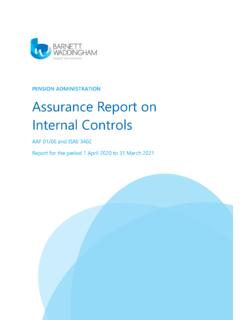Transcription of Investment Insights Sustainability in private markets
1 Investment InsightsSustainability in private marketsIn recent years, Environmental, Social and Governance (ESG) factors have moved from a tick box exercise to the forefront in the minds of investors, corporations, and financial markets . Sustainable investing is one tool investors can use to mitigate Investment risks and access opportunities. Within each asset class, investors can take a myriad of approaches to invest sustainably private markets can offer certain qualities that warrant further Insights - Sustainability in private marketsIn this note, we consider the extent that those investors wishing to invest sustainably can do so via the private markets . We consider whether the differing nature of private markets , compared to public, make the application of a sustainable Investment approach more or less achievable. What is sustainable investing?
2 Before we start to consider the Investment rationale, we need to define what we mean by investing is intentionally investing to achieve measurable social and environmental benefits as well as financial returns. Distinct from ethical investing, which disinvests from assets that are inconsistent with the values of the investors, it instead invests in assets that provide both a positive societal benefit and positive financial returns. Distinct from sustainable investing, impact investing will have a positive non-financial objective as well as a financial investing is intentionally investing in ways that minimise harm on society and/or the environment or contribute towards the long-term Sustainability of the global economy and financial markets . In our view, sustainable investing is driven by financial motivations, such as limiting financial risk and/or accessing opportunities for higher returns.
3 Sustainable investing is not limited to climate risk and includes broader ESG investing and impact investing are two sides of the same coin and the line between the two can sometimes become blurred. Regardless of the underlying motivation, the profit or return on the Investment remains a key objective in either approach. For the purpose of the remainder of this note we focus on sustainable Insights - Sustainability in private marketsWhy is Sustainability important?World leaders recently gathered in Glasgow for the COP26 conference. Mobilising finance was one of the four key pillars of COP26 s agenda, stating that the private sector has a significant role to play in accelerating the transition to a low emission, net zero economy. The opportunity to investors is increasingly clear. The International Energy Agency (IEA) predicts that annual Investment into clean energy needs to rise to $4 trillion by 2030 to achieve net zero emissions by 2050 and limit global warming to This figure compares to $ trillion that the IEA estimate is the current level of entire Investment in the global energy breadth of Investment required for the transition to a green economy is huge, covering decarbonising energy generation, electrification of energy usage, energy storage, and improvements in efficiency of consumption.
4 This is an important point that we revisit later in the note. Changes in government policies and public perception, along with technological advances, are already affecting investors and businesses, resulting in both risks and opportunities. We expect this to continue and, given the scale of climate risk, it is highly likely that governments around the world will be forced into more action. Managing a portfolio s exposure to this risk will be essential to achieving good Investment Insights - Sustainability in private marketsHowever, Sustainability is not just about climate risk. Most investors now agree that it is important to consider ESG factors to both access opportunities for higher returns and manage Investment risk. From a risk management perspective, the emissions scandal at Volkswagen and data privacy issues at Cambridge Analytica are well-known examples of how not taking into account ESG factors could negatively impact your portfolio.
5 While the headlines have been dominated by climate related developments, the Department for Work and Pensions recent call for evidence on social risks and opportunities for occupational pension schemes and efforts by the Taskforce for Nature-related Financial Disclosures highlights the direction of travel for sustainable investing more broadly. This is likely to result in further inflows for sustainable funds. In Europe alone the expected assets under management within ESG private market funds is expected to increase from around $250bn in 2020 to upwards of $800bn by the year 20251. While the US is arguably behind Europe, it will no doubt catch up fast and the extra demand will help to support valuations for sustainable private markets ?Before we combine Sustainability and private markets it s useful to consider the wide range of assets available in private markets .
6 We tend to think of four headline asset classes private equity , private credit, infrastructure, and property. Leveraged buyoutEquityCreditInfrastructureProperty Venture capitalDistressed/ special situationsSeniorMezzanineDistressedCoreC ore PlusValue addedOpportunisticPrimarySecondaryLong-l ease1 Insights - Sustainability in private marketsWhile it can be dangerous to generalise, there are a number of longer-term trends that are affecting the supply and demand of capital to private markets . It is useful to consider and factor these in to any analysis of the role of Sustainability within these asset classes. These key trends include: Low default rates and high recovery levels default rates have remained low in private credit markets and public markets , but recovery rates in direct lending are higher relative to high yield corporate bonds available in public markets .
7 Recovery rates refer to the amount of capital an investor can get back when a company defaults. The yields earned in direct lending are generally higher relative to high yield corporate bonds as they benefit from an illiquidity premium. Increasing number of private companies coming to market notably there are more private companies coming to market than public companies. Companies staying private for longer typically there is more value to be gained in the private stages of a company. With companies staying private for longer, public investors could be missing out on more value. Banks are pulling out of lending private debt began when banks got out of lending after the financial crash and ever since they continue to pull back creating an opportunity set for private lending. Ageing infrastructure even before we consider Sustainability angles, there was a huge need for private capital to support infrastructure needs in both the developed and developing world.
8 In the US, 9% of bridges are in need to be repaired or 1: Recovery levels for public debt (grey bars) versus private debt (blue bars)Source: 2: Withdrawal of domestic bank financing from Europe s non-financial sectorSource: Bank for International Settlements (Euro Area - Credit to private Non-Financial Sector from Banks in US$bn)8,0009,00010,00011,00012,00013,000 14,00015,000US$ (in billions)2 Insights - Sustainability in private marketsThe case for Sustainability in private marketsWe are generally supportive of the Investment case for private markets given these longer-term trends, but what about the role of Sustainability within private markets ? Long-term outlookConcerns that decision making in public markets is driven by short-term considerations have been prevalent for decades. Indeed, those concerns motivated the Law Commission s review into the fiduciary duties of Investment intermediaries in 2014, which culminated in the requirement for pension scheme trustees to include a policy on financially material considerations (including ESG) in their Statement of Investment Principles.
9 Sustainability is a long-term issue. private markets can allow investors to focus on the longer term since it is more difficult to trade assets regularly than in public markets . How this works in practice will depend on the asset class and the fund manager. Taking private equity as an example, the goal is typically to add value and sell up in three to five years. As a result, private equity managers are often accused of being short-term in nature, despite the fact that this timeframe is beyond that of many a public company. Given the focus on Sustainability is increasing at pace, it is evident that over these time periods investors will demand more sustainable companies. This view is shared by fund managers. A 2021 survey conducted by PWC revealed that private equity managers are increasingly acknowledging ESG as a driver of value creation, demonstrating that Sustainability is one of the key components of a value creation toolkit that fund managers can use to increase the attractiveness of investments on exit.
10 There is therefore the potential, at least, for private equity managers to use that additional timeframe to implement changes at a company to put it on a more sustainable, long-term, footing. As noted earlier, this is driven by producing superior Investment Insights - Sustainability in private marketsInfluenceThe Investment manager will generally have a bigger ownership stake in a private company compared to an equivalent publicly listed entity. As a result, they can influence how the underlying businesses or assets are run, including for Sustainability issues. In private equity , managers have typically either selected the management board or have seats on the board putting them in a position of influence. In private debt, fund managers are increasingly incorporating so-called ESG ratchets into the terms and conditions for loans where they are acting as sole, or lead, lender to a company.






